Key West is the
farthest island in the chain linked by road to the mainland. The mainland is 100
miles back along the road, and Cuba 90 miles as the crow flies. So it’s hot,
humid and tropical.
Key West became
American in 1821 having been Spanish before that, except for a 20 year
possession by the British. Its deep water harbour served to increase trade and
importance as a port but the town also prospered from fishing, salt, salvaging
and wrecking. By 1889 Key West was the biggest and most prosperous city in
Florida.
The town centre is
composed largely of grand wooden homes from the 19th century,
similar to many other historic US cities like New Orleans or Charleston.
There are only a
few brick or stone buildings. This is one of them, a copy of Havana Town Hall.
It just needs a model of Fidel Castro on the balcony.
These days, revenue comes mainly from tourism, so make your visit expecting
a generous dose of tourist tat and you won’t be disappointed. We have here in
the next photo the “History of Smuggling and Wrecking Museum”, complete with
watchtower. Outside were people in period costume shouting in Treasure Island “Ar,
there, Jim lad” accents; all good fun.
But of course you
enter into the spirit of it, so we took the trolley tour. These are the little
buses in the photo above. I manage to get a good shot of Kermit, producer of
one of the Islands signature goodies- Key Lime Pie. It’s a kind of lime
flavoured cheesecake dipped in chocolate. We had an ice cream version that was
yummy. I was a little let down that Kermit wasn’t dressed like a frog as per
the Muppets.
We roll past the Hemingway’s
house: the author lived here from 1931 to 1939. It’s probably most famous for
its 6 toed cats, all descended from a cat Hemingway was given by a ship’s
captain. We didn’t see any cats and not much of the house as we sailed by.
Could that be Hemingway’s bike parked by the lamppost?
From cats to
roosters; they are to be seen everywhere, and wander freely as protected
species. They originated from Cuban immigrants who settled in Key West to work
in the many cigar factories that then operated on the island. The Cubans
brought their families and livestock with them. They prospered, and didn’t need
the chickens for eggs or meat anymore, so released them. Opinion is divided;
the tourists love them: they’re colourful, run daringly across busy roads and
are harmless. The residents detest them for their mess and disease carrying potential,
and the noise from the crowing roosters. As with most issues there are valid opposing
viewpoints.
Every visitor takes
this photo: the southernmost point in the USA, looking like a bottle bank. Go
beyond and you fall off the edge of the World.
Parking is
extremely difficult in Key West. We parked the motorhome in a suburban shopping
centre and caught a taxi in. Some No Parking signs are amusing, though, as in
the following photo. Bear in mind that the Keys area is the only frost-free
part of the USA; the lowest temperature ever recorded in Key West is 43 degrees
Fahrenheit.
Wandering around
after the trolley tour it was easier to look closer at some of the sights; this
banyan tree for example. It’s over 100 years old and huge, with aerial prop
roots straying into next door on the right.
The focal point of
the old town is Mallory Square, famous for its sunsets. We were there in the
middle of the afternoon so the square was deserted and not photogenic, so I snapped
this up-market vagrant instead who was sitting in the square. Perhaps I’ve misjudged
him; folks down here dress so casually that he could be the Harbour Master.
On the political
front, Key West was an important naval base from 1823 to 1974, and has played
host to many US Presidents in the residence known as the Little White House. Kennedy
met with the UK’s Harold McMillan here during the Cuba crisis. Eisenhower,
Truman, Clinton and Carter stayed. This is it, although it doesn’t look quite as
imposing as you’d expect.
Key West became
more interesting the more you looked behind the touristy first impression. It has
a fascinating history, linked closely with Cuba, and even established itself as
a separate country in 1982 on a technicality. The Conch Republic, as it calls
itself, has its own flag and passport but graciously allows itself to remain
part of the USA.












No comments:
Post a Comment